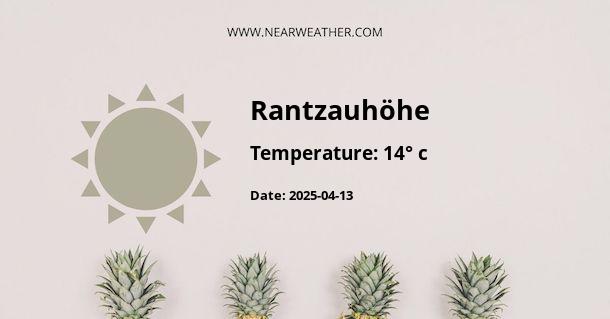The Climate and Weather of Rantzauhöhe, Germany
Rantzauhöhe, located in Germany, experiences a temperate oceanic climate with distinct seasons that bring varying weather conditions throughout the year. The local climate is influenced by Germany's geographical position in Central Europe, as well as the Atlantic Ocean's maritime effect due to the country's northern proximity to the coastline. This region is characterized by relatively mild winters, warm summers, and precipitation distributed fairly evenly across all months.
Overview of the Climate in Rantzauhöhe
The climate classification of Rantzauhöhe falls under the Köppen climate classification as Cfb, which stands for a temperate oceanic climate. The area's atmospheric conditions are heavily affected by the North Atlantic Current, which brings moderate temperatures and moisture-laden air from the ocean. Consequently, the region avoids extremes of temperatures, both in the summer and winter months.
"The climate is a significant factor in both the ecological balance and the daily lives of the region's inhabitants. It influences local flora and fauna, agricultural patterns, and the rhythms of urban and rural lifestyles.” - Climate Research Institute of Germany
Seasonal Weather Patterns
- Spring (March to May): The spring season in Rantzauhöhe is a time of transition, with temperatures gradually warming and daylight hours increasing. Average temperatures range from 5°C to 15°C. Spring often brings a mix of rainy days and bursts of sunshine, leading to a vibrant blooming of local flora.
- Summer (June to August): Summers are warm with temperatures averaging between 16°C and 25°C, occasionally reaching higher during heatwaves. The region enjoys long daylight hours, which, along with the warm weather, is ideal for outdoor activities. However, summer also comes with the risk of sporadic thunderstorms.
- Autumn (September to November): Autumn sees a gradual drop in temperatures, as well as a shift in the scenery with foliage turning into shades of yellow, orange, and red. Temperatures swing from 10°C to 18°C. This season is known for its unpredictability, with a mix of sunny, rainy, and windy days.
- Winter (December to February): Winters are generally cold with an average temperature range of -1°C to 4°C. Snowfall occurs but is not excessive, and there are fewer daylight hours. It is a period marked by overcast skies, with January typically being the coldest month.
Monthly Weather Statistics
| Month | Average High (°C) | Average Low (°C) | Precipitation (mm) | Sunshine Hours |
|---|---|---|---|---|
| January | 3 | -2 | 60 | 40 |
| February | 4 | -1 | 40 | 70 |
| March | 9 | 1 | 50 | 100 |
| April | 14 | 4 | 50 | 160 |
| May | 19 | 8 | 70 | 220 |
| June | 22 | 12 | 70 | 230 |
| July | 24 | 14 | 80 | 240 |
| August | 24 | 14 | 70 | 220 |
| September | 19 | 10 | 60 | 160 |
| October | 14 | 6 | 50 | 110 |
| November | 8 | 2 | 60 | 60 |
| December | 4 | -1 | 70 | 40 |
Factors Influencing Rantzauhöhe's Weather
- Latitude: Rantzauhöhe’s northern latitude results in cold winters due to less solar radiation and cool summers, influenced by the cooler air masses from the North Sea.
- Altitude: Being at a higher altitude can lower the temperature by an average of approximately 0.65°C for every 100 meters above sea level, impacting overall weather patterns and temperature ranges throughout the year.
- Topography: The variance in the area's terrain, including any hills or valleys, can affect microclimates within the region, leading to diverse weather conditions over short distances.
- Proximity to water bodies: The Atlantic Ocean’s moderating influence often reduces temperature extremes and contributes to the area's generally high humidity levels and frequent precipitation.
- Wind patterns: The prevailing westerly winds bring moist air from the Atlantic, contributing to the variable and often unpredictable weather, which includes frequent cloudy skies and precipitation.
Climate Change Impacts on Rantzauhöhe
Climate change is a global phenomenon with localized effects, and Rantzauhöhe is no exception. Trends indicate alterations in the historical weather patterns, such as increased average temperatures, altered precipitation rates, and a higher incidence of extreme weather events. These changes present challenges for the agriculture sector, natural ecosystems, and urban planning in the region. Studies suggest that efforts to improve infrastructure resilience and adaptive measures are crucial in mitigating the adverse effects of these climatic shifts.
Concluding Remarks
Understanding the climate and weather year-round in Rantzauhöhe, Germany, requires a comprehensive look at not just the raw data but also the factors influencing it – geographical, oceanic, and anthropogenic. The region’s temperate oceanic climate provides residents and visitors with a variety of seasonal weather, which shapes the natural beauty and lifestyle of its people.
For individuals planning to visit or relocate to Rantzauhöhe, being aware of the local weather patterns is essential. Whether you are engaging in agricultural activities, planning urban development, or simply packing for a trip, considering the seasonal fluctuations, weather statistics, and long-term climatic changes will ensure a more successful and adaptive approach to dealing with the whims of the local climate.
A - Rantzauhöhe's Latitude is 54.733330 & Longitude is 8.983330.
A - Weather in Rantzauhöhe is 14° today.
A - Climate Conditions in Rantzauhöhe shows overcast clouds today.
A - Humidity in Rantzauhöhe is 86% today.
A - Wind speed in Rantzauhöhe is 23.51 km/h, flowing at 227° wind direction. today.
